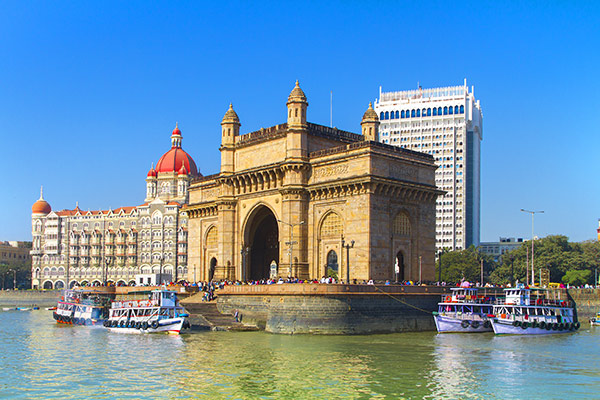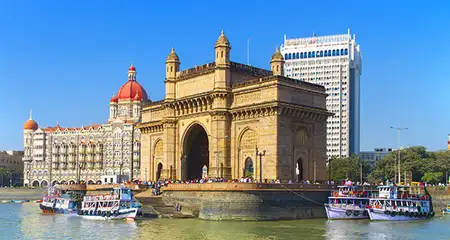Summer, winter, spring or monsoon, the Gateway of India is one of the favorite hangout spots for Mumbaikars. It also counts among the top tourist attractions in Mumbai and is frequented by travelers all year long. With a history of over 100 years, the colossal monument stands overlooking the majestic Arabian Sea, making it a sight to behold. Needless to say, your trip to Mumbai cannot be deemed complete without a visit to the Gateway of India. How about learning a few things about this heritage monument before you step out of your hotels in Mumbai to explore it?
Read on, as we give you all the details about colonial-era structure, including its history, architecture, timings, and other lesser-known facts.
Gateway of India Information:
| Location | Apollo Bundar, Colaba, South Mumbai |
| Timings | 24×7 |
| Entry Fee | Free |
| Status | Monument |
| Nearest Metro Station | Church Gate |
| Year of Establishment | 1924 |
| Architectural Style | Indo-Saracenic |
| Architect | George Wittet |
| Dimensions | 85 feet (height); 48 feet (diameter) |
| Cost of Construction | 2 million (approx. in 1911) |
Gateway of India: History
The Gateway of India was constructed in 1911 to honor the visit and the landing of Queen Mary and King George V at Apollo Bundar. The grand arch monument was designed by a Scottish architect named George Wittet while Sir George Clarke, who was serving as the Governor of Bombay during those times, laid the foundation stone in 1913. Construction of the monument began in 1915, which continued for almost 10 years. On 4th December 1924, the monument was inaugurated by Rufus Isaacs, who was the then Viceroy of India.
After the Gateway was constructed, it served as the ceremonial entry point to India for Viceroys, new governors of Bombay Presidency, and other high-ranking officials. On 25th August 2003, a bomb blast occurred near the Gateway that left bloody trails in front of the monument. The structure, however, didn’t suffer any damage.
Gateway of India Architecture
The Gateway of India is a fine example of the Indo-Saracenic style of architecture. While the spectacular arch has influences of the Muslim architectural style, the decorations reflect the Hindu style. The monument has been constructed using a combination of yellow basalt and reinforced concrete.
The grand arch of the Gateway has a height of 85 feet while the central dome stands with a height of 83 feet and a diameter of 48 feet. You can find 4 turrets adorning this structure, each designed with spectacular latticework. A short flight of stairs erected at the back of the Gateway leads down to the Arabian Sea. There are large halls standing on each side of the arch that can easily accommodate 600 people at a time.
Gateway of India: Today
There’s no doubt that the Gateway of India is among the top tourist places to visit in Mumbai. In fact, the monument is so popular among tourists that it earned the moniker ‘The Taj Mahal of Mumbai’. The monument becomes even more spectacular at night when it is illuminated. It offers spectacular views of the Arabian Sea and the Taj Hotel which is located nearby. Currently, the monument is under the control of the Archaeological Survey of India (ASI).
Ferry Rides at the Gateway of India
When you make a list of the top things to do in Mumbai, a ferry ride at the Gateway of India should be in it. The jetties located around the monument serve as the starting point for many sailing cruises in the city. Maharashtra Tourism Development Corporation (MTDC) also offers ferry services from the Gateway to Elephanta Caves, one of the UNESCO World Heritage Sites in Mumbai.
- Ferry Charges (General): ₹ 150 (approx.)
- Cruise Charges: ₹ 5000 (approx.)
- Ferry Charges to Elephanta Caves: ₹ 150 (adults); ₹ 125 (kids)
Lesser Known Facts about Gateway of India
- Even though the idea behind constructing the monument was to honor the visit of Queen Mary and King George V, the construction of it started only in 1915. A cardboard model of the Gateway was all that the King and the Queen got to see at the time of their visit.
- The huge structure was built at a cost of ₹2 million in 1911. However, due to the lack of funds, the road approaching the Gateway was never constructed.
- When the last troops of the British Empire left India after independence, they passed through this structure, marking the end of the British Empire’s dominion in India.
Attractions near Gateway of India
- Statue of Chhatrapati Shivaji Maharaj (70 m)
- The Taj Mahal Palace and Hotel (77 m)
- Chhatrapati Shivaji Maharaj Vastu Sangrahalaya (900 m)
- Jehangir Art Gallery (900 m)
- Colaba Causeway Market (950 m)
- Chhatrapati Shivaji Terminus ( 3 km)
- Marine Drive (3.2 km)
Whether you are out for an early morning stroll or an evening hangout session, the Gateway of India is the perfect place to visit. Some of the finest restaurants in Mumbai, such as Bademiyan, The Table, Wasabi by Morimoto, Leopold Café, etc. are also located pretty close to the monument. So, go ahead and enjoy your time exploring this heritage structure in Mumbai.





























thanks for useful information.
i am planning a trip there.